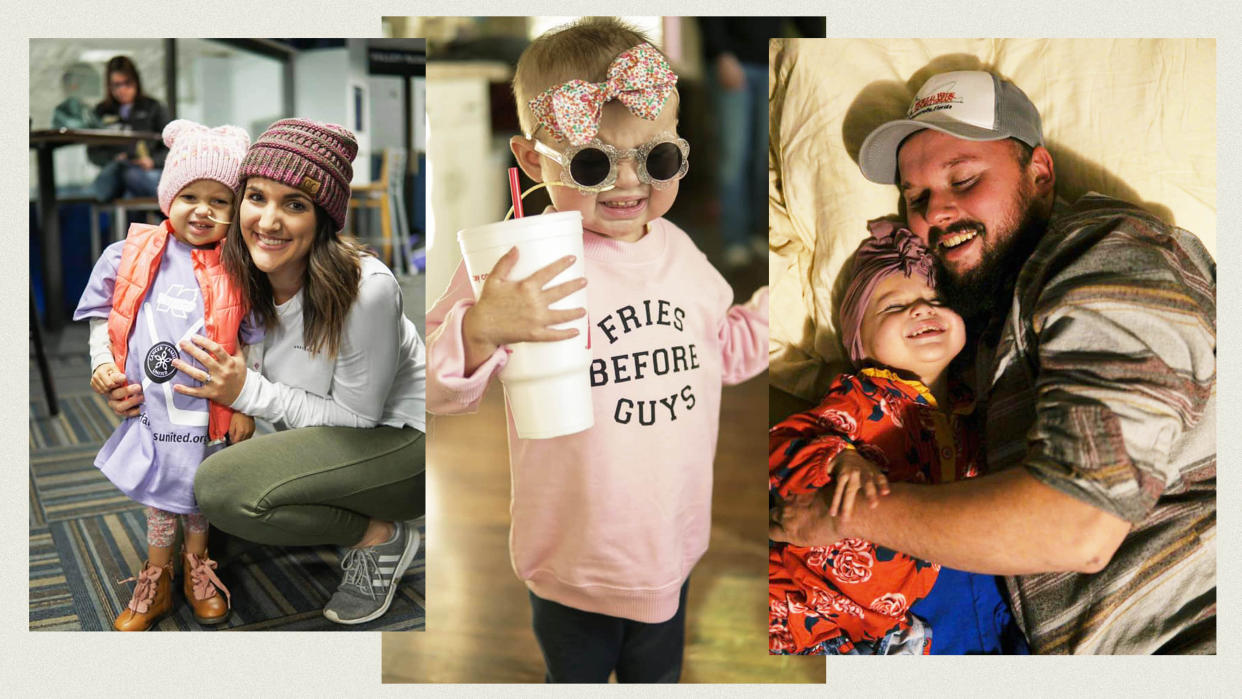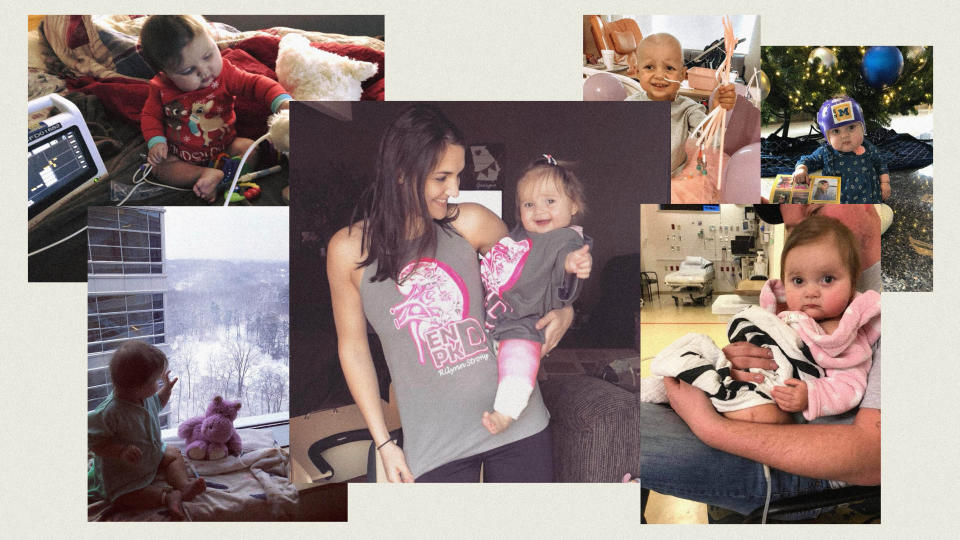Coronavirus Puts 3-Year-Old's Kidney Transplant On Hold

Anguish clouds the joy Emily Payne feels awaiting the arrival of her second daughter, whose birth is expected any day now.
But Payne’s 3-year-old daughter, Rilynn, is also waiting ― for a kidney transplant, one she has needed since birth.
Three times, the Paynes have moved ahead to schedule a transplant. Three times, their hopes were put on hold.
The first time, doctors found cancer in Rilynn’s liver. The second time, Rilynn caught whooping cough, and the living donor also asked for more time.
The third time, they had a new living donor ready for the transplant, but then the COVID-19 pandemic stopped most transplant surgeries, particularly those like Rilynn’s that involve live donors.
The nation’s largest transplant centers have continued to do select, urgent cases using organs donated at death during the pandemic. But most organ transplants from living donors were suspended either because of difficulties transferring organs from deceased donors to other hospitals or because hospitals worried about bringing donors and patients in during a pandemic, said John Magee, Rilynn’s University of Michigan transplant surgeon.
April 19-25 is national Pediatric Transplant Week. More than 1,800 children under the age of 18 await organs nationally, including more than 600 who are 5 or younger, according to Gift of Life Michigan, which is helping the Paynes and other families with virtual support programs during the pandemic. Kidney transplants are the most in-demand across all ages. Of 112,758 Americans waiting for organ donations this week, 94,900 need a new kidney.
I just feel like it seems something always gets in the way. Emily Payne
Dorrie Dils, the nonprofit’s chief executive, expects transplants to pick up as COVID-19 cases decline. “We’re all watching and waiting for those numbers to go down,” she said.
On Wednesday, new national guidelines from the United Network for Organ Sharing, a private, nonprofit that manages the nation’s organ transplant system under contract with the federal government, went into place that allow transplant centers to resume kidney transplants. The change is likely to have the greatest effect on centers that halted all transplant surgeries during the pandemic because of infection, staffing, shortage of intensive care units and other issues, Magee said.
Magee hopes they can do Rilynn’s surgery in late May or June, as the University of Michigan Transplant Center and other facilities return to normal operating schedules.
On Tuesday, a day after her April 20 due date, Payne reacted cautiously to the good news that there may be a new timetable for Rilynn’s surgery.
“Of course, I’m excited to hear that,’’ Payne said. “At the same time, I don’t get stuck on timelines anymore… I just feel like it seems something always gets in the way.”
Surviving Against The Odds
Twenty weeks into what seemed like a routine first pregnancy, a standard ultrasound test tipped off Payne’s doctor that something wasn’t right.
Rilynn’s kidneys were too big.
More ultrasound tests found that her kidneys kept getting larger, which threatened her lungs and heart, and there wasn’t enough amniotic fluid to sustain the pregnancy. The excitement of a first-time pregnancy quickly turned to shock, then despair, recalled Heidi Keister, Emily’s mother, who lives next door to her daughter in Gobles, Michigan, west of Kalamazoo.
Keister filled in many details of her granddaughter’s medical history in a lengthy interview while Payne provided other information in two shorter interviews, between pauses for deep breaths.
“They didn’t expect Rilynn to live through the pregnancy,” Keister said.
Ultrasounds allowed doctors to pinpoint the cause of the enlarged organ: a hereditary kidney disorder known as autosomal recessive polycystic kidney disease (ARPKD), which causes cysts to grow and enlarge the kidneys. It affects one of every 20,000 babies born in the U.S.

About 30% of newborns with the condition die within the first weeks of life, according to the National Institute of Diabetes and Digestive and Kidney Diseases. Those who survive “will likely need medical treatment their whole life,” the agency wrote in a background paper.
In a thick blizzard in January 2017, Payne toured Mott Children’s Hospital, a two-hour ride from home, as she was considering where to give birth (her husband, Zack, was at work). While there, she had another ultrasound. Its findings were alarming. The baby’s heart was shutting down. The doctors told her she’d need to have a C-section right away.
The baby was 5 pounds, 12 ounces and 19 inches long ― normal measurements despite being born at 35 weeks, five weeks early. But so much else was wrong.
When Rilynn was 4 days old, doctors tried to take out her diseased kidneys, but she wasn’t strong enough for the surgery. Three days later, they tried again and had success, but the baby then required dialysis.
“I just remember her being so tiny and lifeless,’’ Keister said. “She didn’t move. I think it was 10 days before Emily could hold her, and we couldn’t touch her.”
Doctors tried to prepare the couple for the likelihood their baby would not live long. “They even went so far as to say you really need to pick out the outfit for her to be buried in,’’ Emily’s mother said. “It was a very intense, emotional time.”
But Rilynn edged forward. After 95 days in the neonatal intensive care unit, she was able to go home on Easter weekend.
More Hard News
Payne learned nursing skills quickly. She fed her daughter with a tube, which turned out to be a blessing. Rilynn was never hungry in the night and slept 10 hours at a stretch, unlike most newborns.
“Looking back now, she did great,’’ said her grandmother. “She’s always been a walking miracle.’’
But she has a weakened immune system and is prone to infections; she’s had pneumonia and Bell’s palsy, which paralyzed part of her face. Always afraid of exposure to germs, the family camped out at home long before social distancing became the American norm.
Rilynn was a curious baby, learning words early. She began to walk later, around age 2.
In August 2018, the family found a friend who agreed to be a donor. But they learned Rilynn had metastatic liver cancer. She still needed a kidney transplant but would need a liver transplant first.
Usually, children at such a young age with hereditary kidney disorders like Rilynn don’t get liver cancer, Magee said. “It was very unusual. It struck us all as a great surprise.”
I’ve learned to stop trying to plan things. At the end of the day, it’s going to work somehow. Emily Payne
They waited nine months, until the parents of a dying child donated a liver.
Payne turned to Facebook to express her gratitude: “Thanksgiving took on a whole new meaning this year. This year I’m most thankful for someone I’ve never even met. A family who chose in their darkest hour to bring light to my world.”
Recovery from the surgery was difficult, with a number of complications afterward. Rilynn had to go back to the operating room at least three times. She spent nine weeks in the hospital. She then went through 15 rounds of chemotherapy. By January 2020, she showed enough improvement to be ready for a new kidney.
But the initial donor asked to push back the transplant date. The Paynes found another donor, but then Rilynn developed whooping cough. Two months passed.
By March 13, she was ready, and the family was waiting for the call that she could go in. Instead, they learned the surgery would have to be postponed again because of the COVID-19 pandemic.
Searching For Hope
There was a 1 in 4 chance that Payne’s second child would also have the disorder. She was a bit of a surprise, but a welcomed one ― and her prenatal scans have been normal.
“Honestly, birth control was the last thing on my mind at the time,” said Payne. “I think it’s the best way for it to happen because we wouldn’t have tried. I wouldn’t say ‘ever,’ but it scares you to try again.”
She posts extensive updates and photos on her Facebook page, Rilynn’s ARPKD Journal, as well as another blog on a pediatric organ website that helped the family raise funds to offset costly transplant expenses.
The entries show Rilynn in moments of both normality and distress, wearing a “Fries before guys’’ sweatshirt with Hollywood-like sunglasses and a bow on her bald head in one, and another sitting in her hospital bed, weak from chemotherapy, hooked to IV and feeding lines. Mostly, the posts are uplifting.
“Rilynn’s scans earlier last month came back perfectly and was the best birthday gift we could ask for,’’ Emily wrote in a Feb. 2 post, one of the more recent. “She celebrated turning 3 with a meat and cheese tray (her request) and a trip to Build a Bear.”
As Payne enters the final days of this pregnancy, she’s trying to avoid stress. “I’m walking around, bouncing on a big ball, trying to get the baby to come out,’’ she said.
Payne said she is reconciled to accepting whatever happens in the next few months as she tries to balance a newborn and lifesaving surgery for her toddler.
“I’ve learned to stop trying to plan things,’’ she said. “At the end of the day, it’s going to work somehow.”
Rilynn’s surgeon is hopeful, too.
“It’s going to be one of those things where 10 years from now we’ll hopefully look and say, ‘Can you believe that’s her? Look how well she’s doing,’” said Magee. “In Rilynn’s case, we’re shooting for a 60-year plan. The 60-year plan means that sometimes today is more painful than you wish it was.”
Love HuffPost? Become a founding member of HuffPost Plus today.
A HuffPost Guide To Coronavirus
Stay up to date with our live blog as we cover the COVID-19 pandemic
What happens if we end social distancing too soon?
What you need to know about face masks right now
How long are asymptomatic carriers contagious?
Lost your job due to coronavirus? Here’s what you need to know.
Everything you need to know about coronavirus and grief
Parenting during the coronavirus crisis?
What coronavirus questions are on your mind right now? We want to help you find answers.
Everyone deserves accurate information about COVID-19. Support journalism without a paywall — and keep it free for everyone — by becoming a HuffPost member today.
This article originally appeared on HuffPost.


